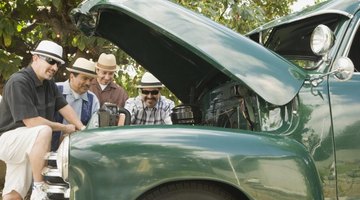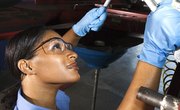If you enjoy making something old look new again and love working with cars, a career in automobile restoration may be for you. Whether the process entails interior repair and polish, body work or glass repair, auto restoration involves making classics look new or fixing damaged cars. Automotive restoration programs teach students the skills needed to obtain a position in this growing field.
Degrees and Programs
Many community colleges and technical schools offer degrees in automotive restoration and repair. Most degrees are associate of applied science degrees, which prepare students for employment immediately upon graduation rather than preparing them for transfer to a four-year college or university. AAS programs generally take about two years to complete. Some schools also offer certificate programs that focus on more specific aspects of auto restoration such as Clover Park Technical College in Lakewood, Washington. Students there may aim for certificates as a refinishing technician, a structure repair technician or in restoration and customization finishing. Certificates typically require about one year of study.
Courses Required
The AAS degree requires some general education, along with the specialized courses in automotive technology. Student often need to take an applied or technical mathematics class, at least one composition or other communications course and an elective from other major categories of humanities, social sciences and foreign language. Classwork also often includes information on the basics of auto restoration and repair such as metal fabrication, body filler, welding, powertrains and chassis function and repair. Specific courses may vary. For example, Pennsylvania College of Technology in Williamsport also demands a course in job estimation and another in auto history.
Hands-on Training
Although some restoration shops hire employees without certification and instead provide on-the-job training, most prefer applicants with a degree. Programs typically combine both classroom and hands-on experience. For instance, Iowa Central Community College's program, offered in various cities, requires students complete two separate restoration projects in their last semester to demonstrate their skills and understanding of the concepts. Most programs include laboratory experience throughout the program. Programs aim for graduates to have knowledge and experience using the tools and equipment necessary for such work.
Job Outlook
According to the U.S. Bureau of Labor Statistics, the number of jobs in automotive restoration is expected to grow about 13 percent through 2022. Although competition for positions should be strong, applicants with degrees or certificates are likely to fare better finding jobs. Graduates of such programs could find work restoration or customization businesses, car museums, auction houses or in service of private collections. More than 10 percent of such workers owned their own shops in 2012, presenting yet another employment option.
Related Articles
References
- Bureau of Labor Statistics: Automotive Body and Glass Repairers
- Genesee Community College: What's the Difference between the AS and AAS Degree?
- Pennsylvania College of Technology: Automotive Restoration Technology
- Clover Park Technical College: Automotive Collision Technician
- Central Carolina Community College: Automotive Restoration Technology Credential: Certificate in Automotive Restoration Technology
- Central Carolina Community College: Automotive Restoration Technology
Writer Bio
Kristie Sweet has been writing professionally since 1982, most recently publishing for various websites on topics like health and wellness, and education. She holds a Master of Arts in English from the University of Northern Colorado.











